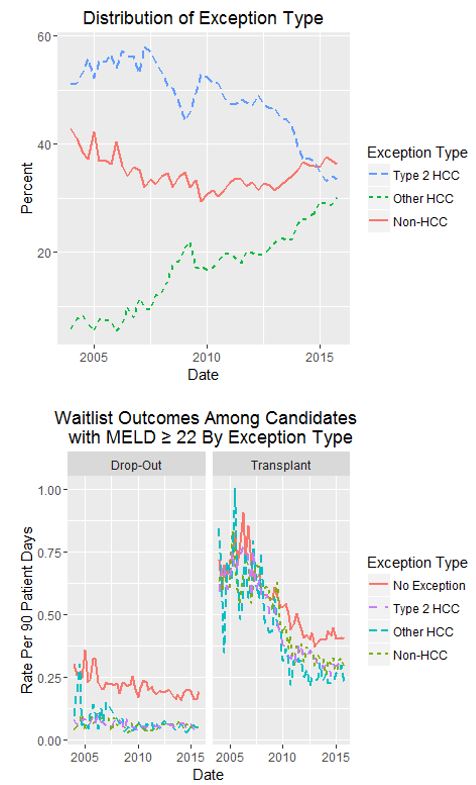Exception Scores for Patients on the Liver Waiting List.
1Scientific Registry of Transplant Recipients, Minneapolis, MN
2Hennepin County Medical Center, Minneapolis, MN
3Stanford University, Stanford, CA
4University of Minnesota, Minneapolis, MN
Meeting: 2017 American Transplant Congress
Abstract number: C199
Keywords: Allocation, Hepatocellular carcinoma, Liver transplantation, Waiting lists
Session Information
Session Name: Poster Session C: Organ Allocation, Meld Score, Organ Utilization, and Transplant Outcomes
Session Type: Poster Session
Date: Monday, May 1, 2017
Session Time: 6:00pm-7:00pm
 Presentation Time: 6:00pm-7:00pm
Presentation Time: 6:00pm-7:00pm
Location: Hall D1
Liver waitlist candidates are prioritized for allocation using model for end-stage liver disease (MELD) scores, and some patients receive higher MELD scores through exception. The number of waitlist candidates with exceptions increased from 445 in 2004 (2.9%) to 2318 (15.9%) in 2014. Hepatocellular carcinoma (HCC) exceptions have been the subject of much discussion in the liver transplant community. We describe trends in the use of HCC and non-HCC exceptions.
Using SRTR standard analysis files, we sampled four quarterly snapshots per year, from 2004 to 2015, and computed: number of candidates, exception status, allocation MELD, and waitlist outcomes 90 days after the snapshot.
Dropout and transplant rates were computed for patients with allocation MELD 22 to focus the comparison on those most likely to undergo transplant. Patients who received a living donor liver and those with allocation status 1, 1A, or 1B were excluded.
Distribution of exception type has shifted, with type 2 (Milan criteria) HCC accounting for 53% of exceptions in 2004 and 34% in 2015, and "other" HCC accounting for 7% in 2004 and 29% in 2015. Ninety-day dropout and transplant rates were similar among the three exception types. We observed decreased transplant rates and relatively constant drop out rates in all exception groups. Transplant rates were similar for candidates with and without exceptions until 2010. After 2010 rates for non-exception candidates were higher. Dropout rates were four to five times higher for non-exception candidates from 2004 to 2015.
While the percentage of candidates with "other" HCC exceptions increased in the last several years, outcomes for those candidates did not differ from outcomes for those with type 2 HCC exceptions.
CITATION INFORMATION: Weaver T, Schladt D, Skeans M, Pyke J, Zeglin J, Leppke S, Israni A, Kasiske B, Kim W, Lake J. Exception Scores for Patients on the Liver Waiting List. Am J Transplant. 2017;17 (suppl 3).
To cite this abstract in AMA style:
Weaver T, Schladt D, Skeans M, Pyke J, Zeglin J, Leppke S, Israni A, Kasiske B, Kim W, Lake J. Exception Scores for Patients on the Liver Waiting List. [abstract]. Am J Transplant. 2017; 17 (suppl 3). https://atcmeetingabstracts.com/abstract/exception-scores-for-patients-on-the-liver-waiting-list/. Accessed January 6, 2026.« Back to 2017 American Transplant Congress
